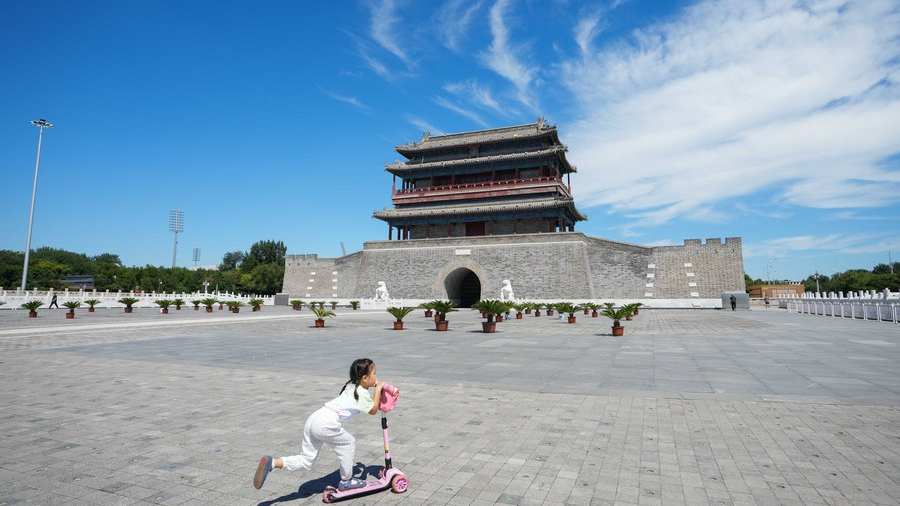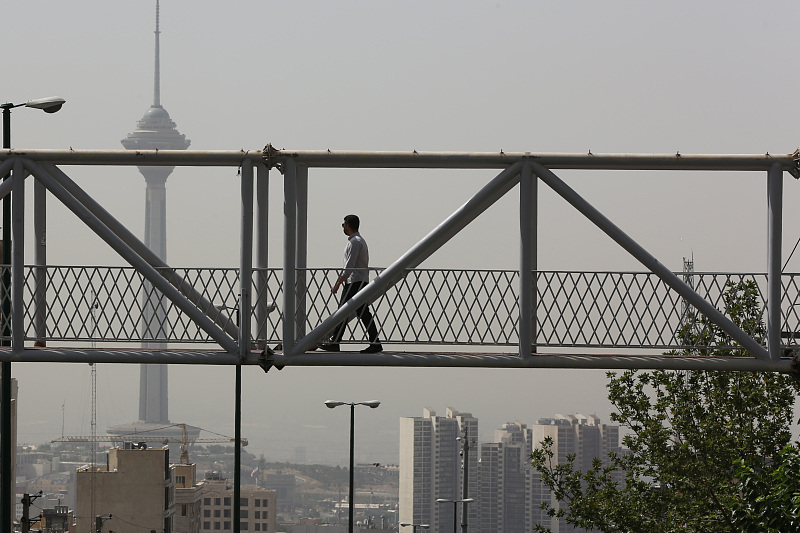
A child plays at the Yongdingmen park in Beijing, capital of China, August 16, 2022. /Xinhua
A child plays at the Yongdingmen park in Beijing, capital of China, August 16, 2022. /Xinhua
Editor's note: Soumya Swaminathan is with the World Health Organization (WHO), Thomas Brooks with the International Union for Conservation of Nature (IUCN), Jurg Luterbacher with the World Meteorological Organization (WMO) and Andrea Hinwood with the UN Environment Programme (UNEP). The article reflects the authors' opinions and not necessarily those of CGTN.
Air pollution is often described as a silent killer. The evidence it leaves behind is conclusive, claiming seven million lives a year – including 600,000 children – and leaving millions fighting infections, lung and heart diseases and cancer. In fact, over 99 percent of humanity breathes air below the air quality guidelines of the World Health Organization (WHO). It especially threatens vulnerable groups like older adults, those with underlying health conditions and children, including those in the prenatal stage.
The agriculture we depend on is severely affected. Exposure to ground-level ozone can lead to reduced yields of staple crops between 1-15 percent and affect their nutritional value. Such crops include wheat, soybeans, rice, and maize, which most of the world's population depends on. When looking for solutions to surging food prices, one measure is to clean up the air that both we and the crops we grow are breathing.
The economy can be severely affected through lost work or school days due to chronic diseases such as asthma, increased health care costs, potentially reduced crop yields, and reduced competitiveness of cities. The World Bank found that the economic cost of the health impacts of air pollution alone amounted to $8.1 trillion, equivalent to 6.1 percent of global GDP in 2019.
Poor people often live closer to sources of emissions and are therefore disproportionately affected, but no one is safe: many air pollutants travel or form in the atmosphere hundreds to thousands of kilometers away from sources of emissions. Even natural sources of air pollution such as soil and desert sand can contribute up to 40 percent of total aerosols in the lower atmosphere, which can remain there for up to a week, traveling across regions and continents.
Air pollution reduces the world's biodiversity and impacts plant growth and photosynthesis. For terrestrial vertebrates alone, there are 7,427 threatened species, of which 1,181 are classified as threatened by pollution and 64 species specifically classified as threatened by air-borne pollutants. Air pollution is also a key factor in the destabilization of the global climate.

A general view of the city turning gray due to the high levels of air pollution in Tehran, Iran, July 4, 2022. /CFP
A general view of the city turning gray due to the high levels of air pollution in Tehran, Iran, July 4, 2022. /CFP
The adoption of coherent policies to reduce emission of climate pollutants could improve air quality. Conversely, they can also aggravate each other in multiple ways, most notably through wildfires with the spread of pollutants like ozone and black carbon.
Air pollution has not been completely solved in any region. Its impacts continue to grow in urban and industrial areas of low- and middle-income countries. As we now know, pollution knows no municipal or national borders. It remains a genuinely global issue that requires global collaboration, inspiring the theme for this year's International Day of Clean Air for Blue Skies: the Air We Share.
The good news is that air pollution is a preventable and manageable threat. Many cities and countries worldwide have shown remarkable decreases in emissions and pollutant concentrations where strong policies, regulations and monitoring systems have been put into place.
UN agencies are committed to an approach that integrates policies on air pollution, climate change, agriculture, health and economic development, and to improving our understanding of these policies' trade-offs. Coordinating national efforts to rapidly reduce air pollution is also upon us.
We would like to see researchers, industry leaders, decision makers and political leaders reciprocate and strengthen cooperation at all scales.
Practically, this means relentlessly improving our understanding of the global distribution of atmospheric pollutants, as well as the necessary set of guidelines to advise countries and cities on how to manage air pollution while delivering co-benefits for climate, food security and sustainable development. It means urgently accelerating and increasing investments made into green energy and transport systems in all countries.
By implementing the WHO's air quality guidelines, we expect countries to see an 80 percent reduction of mortality caused by air pollution, a significant decrease in the burden of diseases and health costs to governments. We would reap tremendous benefits from ploughing residual agricultural waste from a crop into the ground rather than burning it.
Air pollution is taking an immense toll on our health, exacerbates social inequalities, imperils food security and economic development, adds to the decline of biodiversity, and further drives us away from the goals of the Paris Climate Agreement. Smart policies, informed by the interlinkages between these issues, are proving to be tremendously beneficial to the quality of the air we share.
(If you want to contribute and have specific expertise, please contact us at opinions@cgtn.com. Follow @thouse_opinions on Twitter to discover the latest commentaries on CGTN Opinion Section.)

